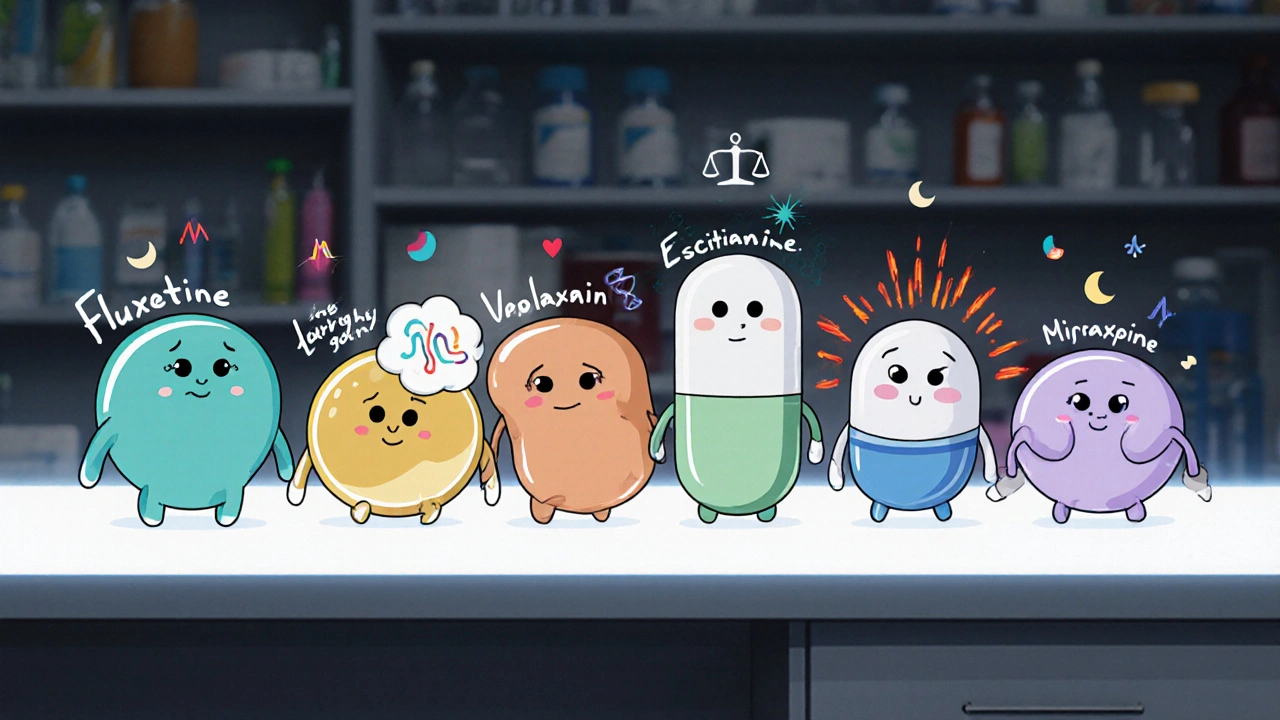Antidepressant Priority Calculator
Find the antidepressant that best matches your priorities by selecting your most important side-effect concerns. Based on clinical data from the article, this calculator compares how each medication addresses your needs.
Your Priorities
Results
Select your priorities to see personalized results.
When doctors prescribe an antidepressant, many patients end up asking, “Is Zoloft the right choice for me, or should I try something else?” This guide breaks down Zoloft vs alternatives by looking at how sertraline stacks up against the most common substitutes, what the trade‑offs are, and how to decide which medication fits your life.
What is Zoloft (Sertraline) and How Does It Work?
Zoloft (Sertraline) is a Selective Serotonin Reuptake Inhibitor (SSRI) used to treat major depressive disorder, anxiety, panic disorder, and OCD. It was first approved by the FDA in 1991 and has become one of the most prescribed antidepressants worldwide.
Sertraline works by blocking the reabsorption (reuptake) of serotonin in the brain, leaving more of the neurotransmitter available to improve mood and anxiety levels. Its half‑life is about 26 hours, which means daily dosing is standard and the drug reaches steady‑state levels in about a week.
Why People Look for Alternatives
Even though Zoloft is effective for many, a sizable portion of patients experience side effects, inadequate symptom relief, or drug‑interaction concerns. Common reasons to explore other options include:
- Persistent nausea, diarrhea, or sexual dysfunction.
- Weight gain or loss that feels unwanted.
- Interaction with other prescribed meds, such as certain blood thinners or migraine treatments.
- Personal preference for a medication with a different dosing schedule or metabolism profile.
Understanding the alternatives helps you and your clinician weigh the pros and cons before making a switch.
Major Alternatives to Zoloft
Below are the most frequently considered alternatives, grouped by class. Each entry includes a brief definition, typical dose range, and a key attribute that often influences choice.
- Fluoxetine (Prozac) is a SSRI with a long half‑life (4‑6 days), making it useful for patients who miss doses. Typical adult dose: 20‑60 mg daily.
- Paroxetine (Paxil) is an SSRI known for strong anxiolytic effects but higher risk of weight gain and withdrawal symptoms. Typical dose: 20‑50 mg daily.
- Escitalopram (Lexapro) is a newer SSRI praised for lower incidence of sexual side effects; dose: 10‑20 mg daily.
- Citalopram (Celexa) is an SSRI with a fairly mild side‑effect profile, but higher doses can affect heart rhythm; dose: 20‑40 mg daily.
- Venlafaxine (Effexor) is a Serotonin‑Norepinephrine Reuptake Inhibitor (SNRI) offering dual neurotransmitter action; dose: 75‑375 mg daily.
- Bupropion (Wellbutrin) is a norepinephrine‑dopamine reuptake inhibitor (NDRI) that avoids sexual side effects but can raise seizure risk at high doses; dose: 150‑450 mg daily.
- Mirtazapine (Remeron) is a noradrenergic and specific serotonergic antidepressant (NaSSA) that often improves sleep but may cause weight gain; dose: 15‑45 mg nightly.
- Tricyclic Antidepressants (TCAs) such as amitriptyline are older agents with strong anticholinergic effects; reserved for treatment‑resistant cases.
- MAO Inhibitors (MAOIs) like phenelzine require strict dietary restrictions and are used when other classes fail.
Side‑Effect Profiles: Zoloft vs the Rest
Every antidepressant carries a risk of side effects, but the pattern differs. The table below captures the most common adverse events reported in large clinical trials (≥1,000 participants) and real‑world post‑marketing surveillance up to 2024.
| Medication | Nausea | Sexual dysfunction | Weight change | Sleep impact | Withdrawal risk |
|---|---|---|---|---|---|
| Zoloft (Sertraline) | 15‑20 | 30‑35 | ±5 % (mostly loss) | Neutral | Moderate |
| Fluoxetine (Prozac) | 10‑15 | 25‑30 | ±3 % (loss) | Insomnia ↑ | Low (long half‑life) |
| Paroxetine (Paxil) | 20‑25 | 35‑40 | +5‑10 % (gain) | Somnolence ↑ | High |
| Escitalopram (Lexapro) | 12‑18 | 20‑25 | ±2 % (neutral) | Neutral | Low‑moderate |
| Venlafaxine (Effexor) | 18‑22 | 28‑33 | ±4 % (gain) | Insomnia ↑ | Moderate‑high |
| Bupropion (Wellbutrin) | 8‑12 | 5‑10 (low) | ±3 % (loss) | Insomnia ↓ | Low |
| Mirtazapine (Remeron) | 5‑10 | 10‑15 | +8‑12 % (gain) | Somnolence ↑ | Low |
Key takeaways:
- Zoloft sits in the middle for nausea and sexual side effects-worse than bupropion but better than paroxetine.
- Weight change is modest with Zoloft, while mirtazapine and paroxetine more often cause gain.
- Withdrawal symptoms are noticeable with sertraline, but fluoxetine’s long half‑life makes tapering easier.

Efficacy Across Conditions
Clinical efficacy is measured by the reduction in standard depression scores (e.g., Hamilton Depression Rating Scale). Meta‑analyses up to 2024 show:
- SSRI class overall achieves an average 3‑point drop versus placebo.
- Sertraline’s effect size (Cohen’s d ≈ 0.46) is comparable to fluoxetine and escitalopram.
- Venlafaxine often shows a slightly larger effect (d ≈ 0.55) for severe depression, but with higher side‑effect burden.
- Bupropion is especially helpful for patients with fatigue or low energy, offering a modest advantage in anhedonia scores.
In anxiety disorders, sertraline and paroxetine have the strongest evidence, while escitalopram is gaining traction for generalized anxiety. For insomnia‑related depression, mirtazapine’s sedating property can be a plus.
Cost and Accessibility in 2025
Price matters, especially in countries with mixed public‑private healthcare. Below is an approximate cost per 30‑day supply in Australia (2025 AUD), based on generic pricing and typical pharmacy discounts.
- Zoloft (generic sertraline): $8-$12
- Fluoxetine: $6-$10
- Paroxetine: $10-$15
- Escitalopram: $9-$13
- Venlafaxine: $12-$18
- Bupropion: $11-$16
- Mirtazapine: $10-$14
Most of these are listed on the Australian Pharmaceutical Benefits Scheme (PBS), meaning subsidized pricing for eligible patients. The biggest price gaps appear with newer agents like escitalopram, which can be slightly higher when brand‑name only.
How to Choose the Right Medication for You
Choosing an antidepressant is rarely a one‑size‑fits‑all decision. Use the following checklist with your prescriber:
- Primary symptom focus: Mood vs anxiety vs insomnia vs low energy.
- Side‑effect tolerance: If sexual dysfunction is a deal‑breaker, consider bupropion or escitalopram.
- Drug‑interaction profile: Review current meds; sertraline has moderate CYP2D6 inhibition, while fluoxetine is a stronger inhibitor.
- Metabolic considerations: Patients with liver impairment may prefer drugs with simpler metabolism (e.g., sertraline is less hepatic).
- Cost/insurance coverage: Check PBS listings; generic sertraline is among the cheapest SSRIs.
- Previous response history: If you’ve tried one SSRI with no effect, an SNRI or NDRI might be warranted.
- Withdrawal concerns: For patients who may miss doses, fluoxetine’s long half‑life offers a safety net.
Don't make the switch on your own. A gradual taper, usually over 2‑4 weeks, reduces discontinuation syndrome risk.

Special Populations
Different groups have unique considerations:
- Pregnant or breastfeeding women: Sertraline is classified Category B (Australia) and has the most safety data among SSRIs.
- Older adults (65+): Lower starting doses (e.g., 25 mg) are advised to avoid hyponatremia; mirtazapine may help with appetite loss.
- Adolescents: Escitalopram and fluoxetine have FDA approval for pediatric depression; sertraline is used off‑label with caution.
Frequently Asked Questions
How long does it take for Zoloft to start working?
Most patients notice an improvement in sleep or anxiety within 1‑2 weeks, but full antidepressant effects often require 4‑6 weeks of consistent dosing.
Can I switch from Zoloft to another SSRI without a washout period?
Yes, most clinicians cross‑taper; you reduce sertraline by 25 % each week while gradually introducing the new SSRI at a low dose.
Is Zoloft safe to take with alcohol?
Moderate drinking isn’t contraindicated, but alcohol can worsen depression and increase side‑effects like drowsiness. It’s best to limit intake.
What should I do if I experience severe nausea on Zoloft?
Take the dose with food, split it into two smaller doses, or discuss a brief trial of an anti‑nausea med with your doctor. If symptoms persist after two weeks, a switch may be needed.
Are generic sertraline tablets identical to brand‑name Zoloft?
Yes, generic sertraline contains the same active ingredient and must meet the same Bioequivalence standards set by the TGA. Inactive fillers may differ, but they rarely affect efficacy.
Bottom Line
Zoloft remains a solid first‑line choice thanks to its balanced efficacy, moderate side‑effect profile, and low cost in Australia. However, alternatives like fluoxetine, escitalopram, venlafaxine, bupropion, and mirtazapine each bring a unique mix of benefits that can better match individual needs. Use the comparison table, side‑effect checklist, and cost overview as a conversation starter with your prescriber, and you’ll be in a stronger position to pick the medication that fits your life.



Sireesh Kumar
October 22, 2025 AT 14:33Alright, let’s break this down. Zoloft is the seasoned veteran in the SSRI arena, and its half‑life makes daily dosing a breeze. It’s proven for depression, anxiety, panic, and OCD, so doctors love the versatility. Side‑effects sit somewhere in the middle – not the worst, not the best. Cost‑wise, it’s a bargain in most markets, especially with generics. In short, it’s a solid first‑line choice for many patients.
Gary Marks
October 23, 2025 AT 18:19Honestly, this guide is a shallow puddle pretending to be an ocean. The author drags on about tables and percentages while ignoring real‑world nuances like patient genetics and lifestyle. Zoloft’s “balanced” profile is a myth; half the users complain about sexual dysfunction that’s brushed under the rug. And why are the costs listed only for Australia? Too myopic. The whole thing feels like a corporate PR dump with a dash of pseudo‑science. If you’re looking for depth, keep scrolling.
Mary Keenan
October 24, 2025 AT 22:06It’s a lazy recap that doesn’t add anything new.
cariletta jones
October 26, 2025 AT 01:53Great effort summarizing the options, and the tone stays upbeat. The concise checklist at the end is especially handy for anyone meeting with their doctor.
Kevin Hylant
October 27, 2025 AT 04:39The guide covers the basics well. It points out that sertraline is less hepatic than some other SSRIs. That’s useful for patients with liver concerns.
Caleb Clark
October 28, 2025 AT 08:26Okay, buckle up because I’m about to drop a ton of info here.
First, sertraline’s neutral impact on sleep makes it a go‑to for night‑time anxiety, but if you’re already dealing with insomnia, you might want to consider mirtazapine’s sedating effect.
Second, the sexual side‑effects you mentioned are real – about a third of patients report reduced libido, which can be a deal‑breaker for many.
Third, if you’re on blood thinners like warfarin, sertraline’s moderate CYP2D6 inhibition is safer than fluoxetine’s strong inhibition.
Fourth, the half‑life of 26 hours means you won’t feel a huge swing if you miss a dose, unlike paroxetine’s shorter half‑life.
Fifth, cost isn’t the only factor; generic availability means pharmacies can stock it without special approvals.
Sixth, the withdrawal syndrome is moderate, so taper slowly over 2‑4 weeks to avoid discontinuation symptoms.
Seventh, for patients with comorbid ADHD, bupropion’s dopaminergic action might give an extra boost of energy.
Eighth, in older adults, start at 25 mg to watch for hyponatremia.
Ninth, if you’re pregnant, sertraline’s Category B status makes it one of the safer SSRIs.
Tenth, remember that interaction with migraine meds like triptans can elevate serotonin too much – watch for serotonin syndrome.
Eleventh, those on antipsychotics should monitor QT intervals even though sertraline has a mild effect.
Twelfth, weight change with sertraline is modest, but if you’re prone to weight loss, consider escitalopram for a neutral profile.
Thirteenth, many patients find taking it with food reduces nausea – simple but effective.
Fourteenth, always talk to your prescriber before switching – cross‑taper is the safest route.
Fifteenth, keep a symptom diary; it helps you and your doctor see what’s really working.
Eileen Peck
October 29, 2025 AT 12:13Thanks for the thorough breakdown, I appreciate the practical tips. I’d add that keeping track of side‑effects in a journal can be a game‑changer. Also, don’t forget to check with your pharmacist about any OTC meds you’re taking – they can interact with SSRIs. Lastly, a gentle reminder: never stop a med cold turkey.
Oliver Johnson
October 30, 2025 AT 15:59Look, most of this stuff is just regurgitated pharma fluff. The “best first‑line” claim ignores the fact that many patients respond better to newer agents that aren’t even mentioned. Also, the focus on cost in Australia is absurd when the US market is totally different. If you truly want to help patients, you’d highlight personalized medicine over blanket statements.
Taylor Haven
October 31, 2025 AT 19:46While some might say the guide is thorough, we must consider the bigger picture. Pharmaceutical companies have a vested interest in pushing SSRI sales, and the subtle positioning of Zoloft as the “balanced” choice could be a marketing ploy. Many independent studies suggest that the efficacy differences among SSRIs are negligible, yet the guide spends extra lines on sertraline’s half‑life. This could mislead patients into thinking it’s inherently superior. Moreover, the side‑effect tables lack nuance about long‑term metabolic impacts that are under‑reported. The omission of alternative therapies like psychotherapy is a glaring oversight. And let’s not forget the possible bias in cost listings – they only show the cheapest region, ignoring the reality for many who pay out‑of‑pocket.
Jonathan Harmeling
November 1, 2025 AT 23:33It’s commendable to give patients a menu of options, yet moral clarity is needed. The narrative should stress that any medication must be paired with a solid support system, not just a pill. Underplaying the psychosocial dimension could be harmful. A balanced view would also address stigma surrounding mental health treatment.
Ritik Chaurasia
November 3, 2025 AT 03:19Let’s cut to the chase – Zoloft is not a one‑size‑fits‑all miracle. If you’re from a culture that values holistic health, you deserve more than a generic SSRI recommendation. Push your doctor to consider lifestyle, diet, and alternative therapies alongside any prescription. The guide should have highlighted that.
Vandermolen Willis
November 4, 2025 AT 07:06Nice summary! 👍 I think the checklist will help many people talk to their doctors. 😊